Australian forests in the process of restoration after devastating fires
December 8, 2021
Towards the end of 2019, the world was shaken by the catastrophic news of forest fires ravaging the eastern and southern coasts of Australia. An estimated 46 million acres of woodland were burned. But now, as the ash settles and the smoke clears, Australia may see a glimmer of hope for its forests.
The fires are considered Australia’s worst disaster in its history. The area of land that was affected is larger than Holland, Denmark, and Switzerland combined. In addition, nearly three billion animals were killed or displaced in the fires.
“I knew it [forest recovery] would be possible because forests have that ability, but because of how extensive it was, I assumed it would be a big, long process,” said Chelsea George, a chemistry teacher at Wakefield High School.
Though nature has a way of growing back stronger than before, that doesn’t mean they’re not harmful to other things, such as endangered plants and animals.
“The wildfires were disastrous to the country,” said Wakefield junior Alexis McCarrick. “It destroyed so much land and many animals. It’s really sad.”
Trees that had been scorched by the flames began to regrow in early 2021 –an encouraging sign for environmentalists around the globe. Re-growing plants are also adapting to withstand future bushfires.
The Bushfire Recovery Project is a project created to maintain and preserve the forests that have previously been burned in fires. It was formed following the 2019-20 bushfire season, and brings together fire experts, scientists, and community volunteers to produce data that can assist with developing plans for fire prevention.
They have been tracking forest regrowth weekly in areas of New South Wales and Victoria. Resprouting is occurring in areas along the South Coast, and according to the lead members of the Bushfire Recovery Project, this is very optimistic news.
Hayden Schug, an animal science and horticulture teacher at Wakefield High School, makes a point that controlled fires are healthy –even beneficial.
“The problem now is that we don’t allow fires to happen,” said Schug. “We need forest fires to help trees re-emerge. They [Australia] just hadn’t done a burn in a long time, and so what happened was the base of the forest built up with debris, and everything burned hotter.”
In addition, thousands of protestors across Australia have rallied together against the government in wake of the fires and lack of action. They claim that the fires are linked to climate change, and are preventable as long as the government begins to dedicate time, money, and attention to the problem.
Joshua Potter, a Wakefield junior, shared his opinion on the Australian government’s response.
“The lack of action even after such a bad fire makes me feel scared for the future,” said Potter. “People need to become more aware of the earth.”
Work is being done across the globe to assist the survival of fire-scorched trees and newly grown ones. Dedicated volunteers are working to preserve bushfire-affected areas and woodlands. Australia may have been damaged –seemingly beyond repair –but once again, mother nature proved her strength as the woodland begins to start its healing and regrowth.









